Ludhiana
Ludhiana is a city and a municipal corporation in Ludhiana district in the Indian state of Punjab.
Ludhiana | |
|---|---|
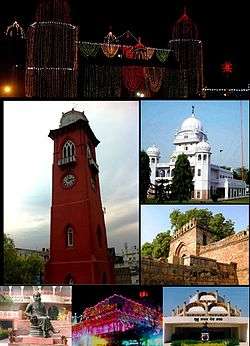 Gurudwara Sri Dukhniwaran Sahib, Clock Tower, Gurudwara Shri Manji Sahib Alamgir, Lodhi Fort, Maharaja Ranjit Singh War Museum, Shri Krishna Mandir and Guru Nanak Dev Bhavan, Tiger Safari | |
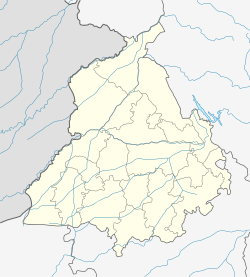 Ludhiana  Ludhiana  Ludhiana | |
| Coordinates: 30.91°N 75.85°E | |
| Country | |
| State | Punjab |
| District | Ludhiana |
| Tehsil | Ludhiana West Ludhiana East |
| Government | |
| • Type | Mayor–Council |
| • Body | Ludhiana Municipal Corporation |
| • Mayor | Balkar Sandhu[1] (INC) |
| Area | |
| • Total | 310 km2 (120 sq mi) |
| Elevation | 262 m (860 ft) |
| Population (2011)[2] | |
| • Total | 1,618,879 |
| • Rank | 22nd |
| • Density | 5,200/km2 (14,000/sq mi) |
| Demonym(s) | Ludhianvi |
| Time zone | UTC+5:30 (IST) |
| PIN | Multiple 141001-141016 |
| Telephone code | 0161 |
| Vehicle registration | PB-10, PB-91 |
| Website | http://www.ludhiana.nic.in/ |
Ludhiana is Punjab's largest city and India's largest city north of Delhi, with an area of 310 sq. km and an estimated population of 1,618,879 as of the 2011 census.[2] The city stands on the Sutlej River's old bank, 13 kilometres (8.1 mi) south of its present course. It is an industrial center of northern India; the UK's BBC has called it India's Manchester.[3] Ludhiana was among the list of smart cities that will be developed by government of India. Ludhiana is the easiest city in India to do business according to the World Bank. It is ranked first in paying taxes, second in resolving insolvency, fourth in contract enforcement, and seventh in starting a business.[4]
Ludhiana is 107 kilometres (66 mi) west of the state capital, Chandigarh, on NH 95, and is centrally located on National Highway 44, which runs from New Delhi to Amritsar. It is 315 km (194 miles) north of Delhi and 142 km (88 miles) southeast of Amritsar.
Geography
Ludhiana is located at 30.9°N 75.85°E.[5] It has an average elevation of 244 metres (798 ft). Ludhiana City, to its residents, consists of the Old City and the New City (or the residential and official quarters of the colonial British encampment, traditionally known as Civil Lines; this is as opposed to the Army Lines, which are no longer extant as the British Cantonment was abandoned in 1845).
The land dips steeply to the north and the west where, before 1785, the river Sutlej ran.
The Old Fort was at the banks of the Sutlej (and now houses the College of Textile Engineering). Legend has it that a tunnel connects it to the fort in Phillaur – although why this should be is debatable, as the Sutlej was the traditional dividing line between the principalities, often occupied by enemy forces (see History section).
The ground is of yellow sandstone and granite, forming small hillocks, plateaus and dips.
The tree of largest natural extraction was the kikar, or Acacia indica, but has been supplanted by the eucalyptus, transplanted from rural Australia in the late 1950s by the government of Chief Minister Pratap Singh Kairon.
Gulmohars and jacarandas were planted by the British along the avenues of Civil Lines, as were other flowering trees, while the Old City contains almost no vegetation or parks, except for a few isolated pipal trees, holy to the Hindus, as it is supposed to be the abode of Lord Shiva.
Climate
Ludhiana features a semi-arid climate under the Köppen climate classification, with three defined seasons; summer, monsoon and winter. Ludhiana on average sees roughly 809.3 millimetres (31.86 in) of precipitation annually. The official weather station for the city is in the compound of the Civil Surgeon's Office to the west of Ludhiana. Weather records here data back to 1 August 1868.
Ludhiana has one of the worst air pollution problems in India, with particulate matter being over six times the World Health Organization recommended standard, making it the 13th most polluted city in the world.[6][7] Industrial water pollution is also of significant concern in portions of Ludhiana, notably along the Budha Dariya.[8]
| Climate data for Ludhiana (1981-2010 normals, extremes 1868–present; relative humidity 1961-1990) | |||||||||||||
|---|---|---|---|---|---|---|---|---|---|---|---|---|---|
| Month | Jan | Feb | Mar | Apr | May | Jun | Jul | Aug | Sep | Oct | Nov | Dec | Year |
| Record high °C (°F) | 29 (84) |
30.4 (86.7) |
36.3 (97.3) |
43.4 (110.1) |
46.6 (115.9) |
46.6 (115.9) |
43.2 (109.8) |
39.8 (103.6) |
37.9 (100.2) |
36 (97) |
35.1 (95.2) |
27.9 (82.2) |
46.6 (115.9) |
| Mean maximum °C (°F) | 23.8 (74.8) |
26.9 (80.4) |
32.6 (90.7) |
40.7 (105.3) |
43.8 (110.8) |
43.5 (110.3) |
37.9 (100.2) |
35.8 (96.4) |
35.6 (96.1) |
34.7 (94.5) |
30.7 (87.3) |
25.1 (77.2) |
44.8 (112.6) |
| Average high °C (°F) | 18.6 (65.5) |
22.2 (72.0) |
27.3 (81.1) |
35 (95) |
38.9 (102.0) |
37.9 (100.2) |
34 (93) |
33.1 (91.6) |
33 (91) |
31.9 (89.4) |
27.3 (81.1) |
21.6 (70.9) |
30.1 (86.2) |
| Average low °C (°F) | 5.6 (42.1) |
8.2 (46.8) |
12.3 (54.1) |
17.7 (63.9) |
22.9 (73.2) |
25.3 (77.5) |
25.8 (78.4) |
25.1 (77.2) |
22.8 (73.0) |
16.5 (61.7) |
10.7 (51.3) |
6.5 (43.7) |
16.6 (61.9) |
| Mean minimum °C (°F) | 1.2 (34.2) |
3.4 (38.1) |
7.3 (45.1) |
12 (54) |
17.6 (63.7) |
20.5 (68.9) |
22 (72) |
21.7 (71.1) |
18.8 (65.8) |
12.6 (54.7) |
6 (43) |
2.5 (36.5) |
0.8 (33.4) |
| Record low °C (°F) | −1.7 (28.9) |
−0.1 (31.8) |
4.6 (40.3) |
9.5 (49.1) |
13.6 (56.5) |
16.1 (61.0) |
20.4 (68.7) |
18 (64) |
15.5 (59.9) |
10.6 (51.1) |
3.1 (37.6) |
0.1 (32.2) |
−1.7 (28.9) |
| Average rainfall mm (inches) | 28.3 (1.11) |
37 (1.5) |
29.9 (1.18) |
17.3 (0.68) |
22.3 (0.88) |
69.2 (2.72) |
215 (8.5) |
205.2 (8.08) |
146 (5.7) |
19.8 (0.78) |
4.3 (0.17) |
15.1 (0.59) |
809.3 (31.86) |
| Average rainy days (≥ 1.0 mm) | 2.2 | 2.7 | 2.4 | 1.7 | 2 | 4.3 | 8.4 | 8.6 | 5 | 1 | 0.6 | 1 | 39.9 |
| Average relative humidity (%) | 74 | 66 | 62 | 44 | 39 | 49 | 71 | 76 | 68 | 61 | 68 | 74 | 63 |
| Source: Ludhiana Climatological Table, 1981-2010 "Ludhiana Climatological Table, 1981-2010" (PDF). India Meteorological Department. Retrieved 2 April 2020.</ref> | |||||||||||||
Demographics
As per provisional data of 2011 census Ludhiana had a population of 1,618,879.[2] The literacy rate was 82.50 per cent.[10] This population consists of 950,123 males and 743,530 females.[2]
Religion
With around 66% adherents according to 2011 Indian Census, Hinduism is the predominant religion of Ludhiana, followed by Sikhism with 29% of the population. Islam is followed by around 3% and Christianity by less than 1%.[9]
Prior to India's partition, Ludhiana had a population of 111,639 with Muslims being the majority with 63%. The Hindus were 31% and Sikhs 5%. It changed post partition with a drastic reduction in Muslim percentage and simultaneous increase in Hindu and Sikh population, owing to migration of people between West and East Punjab.[11]
Economy
The World Bank ranked Ludhiana as the city in India with the best business environment in 2009 and 2013.[12] The riches are brought mostly by small-scale industrial units,[13] which produce industrial goods, machine parts, auto parts, household appliances, hosiery, apparel, and garments. Ludhiana is Asia's largest hub for bicycle manufacturing and produces more than 50% of India's bicycle consumption of more than 10 million each year. Ludhiana produces 60% of India's tractor parts and a large portion of auto and two-wheeler parts. Many parts used in German cars Mercedes and BMW are exclusively produced in Ludhiana to satisfy the world requirement. It is one of the largest manufacturer of domestic sewing machines. Hand tools and industrial equipment are other specialties. Ludhiana contribute most to Punjab than any other city.
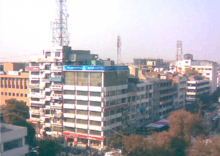
The apparel industry of Ludhiana, popularly known as Ludhiana Hosiery industry provides employment to millions of people[14] and produces India's largest share of winter clothing. It is especially known for its woollen sweaters and cotton T-shirts with the majority of India's woollen clothing brands being based here. Ludhiana is also famous for its industry of shawls and stoles and satisfies the demand of major domestic and international brands. As a result of its dominance in the textile industry it is often dubbed as the Manchester of India.[15] Ludhiana also has a growing IT sector with multiple software services and product companies having development centers in the city.
Ludhiana is also home to the Ludhiana Stock Exchange Association. LSC is situated on NH95(Chandigarh-Ferozepur Highway) in Feroze Gandhi market near Mini Secretariat Ludhiana.
Education
Schools
Ludhiana has 363 senior secondary, 367 high, 324 middle, 1129 primary, and pre-primary recognised Schools, with a total of 398,770 students.[16] Most of these schools are either run by the Central Board of Secondary Education or by Punjab School Education Board.[17]
Agriculture
Ludhiana is home to the largest agricultural university in Asia and one of the largest in the world, Punjab Agricultural University.[18] The College of Veterinary Sciences at PAU was recently upgraded to the Guru Angad Dev Veterinary and Animal Sciences University (GADVASU).
GADVASU was established at Ludhiana by an act of the Punjab Legislature No. 16 of 2005 notified in the Punjab Government Gazette on 9 August 2005 and it started functioning w.e.f. 21 April 2006 for promoting livestock production, health and prevention of the disease(s) through integrated teaching, research and extension programme(s).
Medical
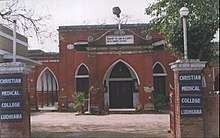
Christian Medical College, Ludhiana, the first medical school for women in Asia, was founded by Dr Dame Edith Mary Brown in 1894. Christian Medical College is a major and reputed tertiary care hospital in India where the world's first face transplant was done. Dayanand Medical College and Hospital is a tertiary care teaching hospital in Ludhiana. This institution is recognised by the Medical Council of India. The college is affiliated to Baba Farid University of Health Sciences, Punjab. Guru Teg Bahadur Institute of Nursing, Ludhiana was established in the year 1997, Guru Teg Bahadur Institute of Nursing, Ludhiana is affiliated to Baba Farid University of Health Sciences (BFUHS) Faridkot.
Engineering

Guru Nanak Dev Engineering College is an institution offering facilities and education for engineering students. It has a research and development centre for bicycles and sewing machines.[19] There is also the Research & Development Polytechnic College.[20] There are also other institutes catering to local and surrounding areas such as Institute of Banking Services (IBS).
Management
Ludhiana has many management colleges providing courses such as Bachelor of Business Administration (BBA), Hospitality and Management (HM), Airlines Tourism and Hospitality Management (ATHM), Bachelor of Computer Applications (BCA), and Bachelor of Commerce (B.Com).
There are a few good colleges providing these courses both part-time as well as full-time, such as University Business School (UBS), Panjab University Regional Centre, the Punjab College of Technical Education (PCTE), Synetic Business School (SBS) Punjab Agricultural University (PAU), Sri Aurobindo College of Commerce and Management (SACCM), Guru Nanak Institute of Management & Technology (GNIMT) and Government college for boys and Government college for girls. Khalsa College and Arya college are also present to study as a part-time student.
SCD Govt College - SCD Govt College earlier known as SD college was renamed in 1976 after the name of great scientist and physicist Satish Chandra Dhawan. Mr Dhawan was the mentor of India's most favourite president Dr. APJ Abdul Kalam. SCD is situated at the College Road near Nehru Rose garden. SCD college is considered as the top most college of Panjab University and one of the top colleges of north India. It offered academic courses on graduate and post graduate level.
Transportation
Ludhiana is well connected by road and rail as Ludhiana railway station is on the main Delhi-Amritsar route and is an important railway junction with lines going to Jalandhar, Ferozepur, Dhuri and Delhi. The city is very well connected with daily or weekly trains to most places in India including the major cities of Jammu, Amritsar, Jalandhar, Patiala, Pathankot, Kanpur, Jaipur, Chandigarh, Ambala, Panipat, Delhi, Mumbai and Kolkata. For administrative reasons the station is under Ferozepur Railway Division. The railway line between Ludhiana and Chandigarh opened in 2013. The government has even passed a dedicated freight track between Ludhiana and Kolkata.
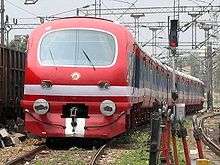
Road
Ludhiana is connected with other cities of Punjab and also with other states by bus service. Major national highways NH 44, NH 5 (old NH1, NH95) and state highway SH 11 connect to the city.[21][22] The transportation services are provided by the state owned Punjab Roadways and private bus operators.
Airport
Ludhiana is served by the city based Sahnewal Airport ((IATA: LUH, ICAO: VILD)), also known as Ludhiana Airport. It is located near the town of Sahnewal, 5 km (3.1 mi) southeast of Ludhiana on the Grand Trunk Road. The airport is spread over more than 130 acres. The current airport arrival/departure halls can accommodate 40 passengers.[23] New Ludhiana International Airport is coming up at Halwara Air Force Station which is expected to be completed in three years. The other airports near Ludhiana are Adampur Airport in Jalandhar, Chandigarh Airport and Sri Guru Ram Dass Jee International Airport.
Railway
Ludhiana Junction railway station is connected to other metro cities. 12037/New Delhi - Ludhiana Shatabdi Express is an important train that starts here. It also has Sahnewal, Doraha, Kila Raipur railway stations which serve domestic and passenger trains. Vande Bharat Express has a stop at Ludhiana junction on its New Delhi (NDLS) - Shri Mata Vaishno Devi Katra (SVDK) route.[24]
Ludhiana Metro
This project has been scrapped by the government because lack of funds.
The government has signed a Memorandum of Understanding with Delhi for construction of a Ludhiana Metro. This light transit system will serve about 25 years to Ludhiana. There will be two corridors in Ludhiana Metro. These two corridors of metro will give relief to many roads to some extent.
City transportation
City bus service has been cancelled. Moving around inside the city is done mostly by city-buses, auto-rickshaws, and cycle rickshaws, while latest Ludhiana BRTS was planned to be constructed but due to lack of funds allotted and weak planning and management the project too has been scrapped by the government thus worsening the traffic problems in the industrial city.
Auto rickshaw
The Auto rickshaw is a three-wheel drive vehicle, which is one way to travel in the city. They have the capacity to hold three to six passengers. It can be hired individually or on a sharing basis. The auto rickshaws are easily available at every major place, including the interstate bus terminal and the railway station at a nominal fare which varies from ₨ 10 to ₨ 30. Jugnoo, an on demand auto rickshaw application launched its operations in February 2015 to provide low cost, reliable, 24 × 7 service to the citizens of Ludhiana.
Rickshaw
Cycle rickshaws are widely used in Ludhiana. The rickshaw or tricycle is pulled by a person and is a relatively cheap way of travelling in the city, but has become pricey after the autos were being scrapped. Nowadays many electric rickshaws are also available in Ludhiana and most of them can be spotted on the road which connects Samrala Chowk to Station.
Attractions
.jpg)
Kabaddi
Guru Nanak Stadium is known for hosting the Kabaddi matches along with athletic games. Kabaddi world cup finals have been played twice in Guru Nanak Stadium Ludhiana.[27] The stadium often hosts high-profile Kabbadi matches.
Kila Raipur Sports Festival
Kila Raipur Sports Festival, popularly known as Rural Olympics or Mini olympics,[28] is held annually in Kila Raipur, near Ludhiana. Competitions are held for Punjabi rural sports, including cart races, kabaddi and rope pulling.
Punjab Agricultural University Stadium is a multipurpose stadium located in the campus. The stadium has facilities for sports like cricket, football, hockey, etc. There is an astroturf field for hockey which is used for hockey events. In addition to this there is a swimming pool and a cycling Velodrome.
There are facilities for indoor sports such as basketball, badminton, gymnastics, handball, volleyball, lawn tennis, table tennis, weight lifting and Kabbadi, etc. The ground also has hosted 10 Ranji including a final in 1993 and one Irani Trophy matches from 1987 to 1999 and 10 List A matches.
Places of interest
- Alamgir
- Doraha
- Jagraon
- Katana Sahib
- Khanna
- Kila Raipur
- Machhiwara
- Nanaksar
- Payal
- Serai Lashkari Khan
- Sidhwanbet
- Sudhar
- Mullanpur Dakha
 Nanaksar Kaleran
Nanaksar Kaleran Hotel Majestic Park Plaza
Hotel Majestic Park Plaza Railway Station
Railway Station
 Hotel Regenta Central Klassik
Hotel Regenta Central Klassik Guru Nanak Dev Engg. College
Guru Nanak Dev Engg. College
Notable individuals
- Sukhdev Thapar, Freedom fighter
- Kartar Singh Sarabha, Freedom fighter
- Gippy Grewal, Singer, actor
- Sukh Sanghera, Film director and music video director
- Bhai Randhir Singh, Freedom fighter
- Neel Kamal Puri, novelist, columnist[29]
- Dharmendra, actor
- Sunil Mittal, entrepreneur, founder of Airtel and Bharti Enterprises
- Simarjit Singh Bains, Social worker, politician
- Sahir Ludhianvi, lyricist
- Sukhdeep Singh Chakria, Boxer
- Divya Dutta, actress
- Diljit Dosanjh, Singer, actor
- Manjit Rupowalia, Singer
- Brijmohan Lall Munjal, Industrialist, founder of Hero Group
- Rajinder Gupta, Industrialist, Chairman of TridentGroup
- Trishneet Arora, Ethical hacker, author
- Shubha Phutela, actress
- Dakssh Ajit Singh, actor
- Jainti Dass Saggar, Physician, politician
- Ravikiran Khangura, Singer, actor
- Abhinav Shukla, actor
- Sudarshan Agarwal, politician
- Shilpi Sharma, actress
- Gulzar Singh Sandhu, writer
- Naina Dhaliwal, Indian model
- Inderjit Hasanpuri, songwriter
- Ram Singh, Social reformer
- Maulana Habib-ur-Rehman Ludhianvi, One of the founders of Majlis-e-Ahrar-e-Islam
- Barkat Ali Ludhianwi, Muslim Sufi and founder of the Dar ul Ehsan organisation
- Talish, Pakistani actor
- Raj Khosla, director
- Baldev Raj Chopra, Producer and director
- Kuldeep Manak, Singer
- Inderjit Nikku, Singer
- Ravinder Grewal, Singer
- Amar Singh Chamkila, Singer
- Surinder Shinda, Singer
- Karnail Gill, Singer
- Ishmeet Singh, Singer
- Lal Chand Yamla Jatt, Singer
- Mandeep Singh Cricketer
- Pankaj Kapoor Actor
- Hardev Dilgir, lyricist
- Saadat Hasan Manto, writer, playwright
- Ish Sodhi, New Zealand Cricketer
- Happy Raikoti, lyricist, singer
- Komal kumarr Jain , India's top Industrialist, textile sector
References
- Bhardwaj, Nidhi (26 March 2018). "Balkar sandhu becomes mayor of Ludhiana | Ludhiana News - Times of India". The Times of India. Retrieved 14 August 2019.
- "Area and Population". Official Website of Ludhiana. Archived from the original on 7 March 2016. Retrieved 4 March 2016.
- "India's Manchester". BBC. 28 February 2006. Archived from the original on 18 August 2014. Retrieved 25 May 2014.
- "Sub National". World Bank. Retrieved 10 October 2019.
- "Falling Rain Genomics, Inc – Ludhiana". fallingrain.com. Archived from the original on 29 May 2008. Retrieved 8 June 2008.
- Majeed, Shariq (26 March 2014). "Ludhiana worries over its PM". The Times of India. Archived from the original on 27 March 2014.
- Preet, Jatinder (16 October 2011). "Ludhiana fourth most polluted city in the world". The Sunday Guardian. Delhi, India. Archived from the original on 12 April 2014.
- "How air and water pollution plagues Indian cities". Hindustan Times. 1 December 2013. Archived from the original on 29 January 2014.
- "C-1 Population By Religious Community - Ludhiana (M. Corp)". Retrieved 2 December 2019.
- "Urban Agglomerations/Cities having population 1 lakh and above" (PDF). Provisional Population Totals, Census of India 2011. Archived (PDF) from the original on 2 April 2013. Retrieved 7 July 2012.
- Virdee, Pippa (February 2018). From the Ashes of 1947. Cambridge University Press. p. 138. ISBN 978-1-108-42811-8.
- "Doing Business in India 2009". World Bank. Archived from the original on 7 October 2010. Retrieved 8 June 2010.
- Entrepreneurship in India's small-scale industries. Richard P. Taub, Doris L. Taub
- VIBES, CITY. "LUDHIANA PORTAL Digital directories & Newspapers". CITY VIBES. Archived from the original on 15 December 2018. Retrieved 12 December 2018.
- "Punjab industry gives thumbs down to Arun Jaitley's Union Budget". www.hindustantimes.com. 1 February 2018. Archived from the original on 5 December 2018. Retrieved 12 December 2018.
- "Education and Medical Facilities - Official Website of Ludhiana". Archived from the original on 22 December 2015.
- VIBES, CITY. "Digital directories & Newspapers". CITY VIBES. Archived from the original on 1 November 2018. Retrieved 1 November 2018.
- Ludhiana Colleges Archived 2 December 2011 at the Wayback Machine. Mapsofindia.com. Retrieved on 16 June 2014.
- "www.bsrdindia.com". Archived from the original on 1 August 2015. Retrieved 27 July 2015.
- "R&D Polytechnic College". Archived from the original on 7 September 2015. Retrieved 27 July 2015.
- "State Highways in Punjab". PWD - Govt. of Punjab, India. Archived from the original on 25 May 2018. Retrieved 25 May 2018.
- "National Highways in Punjab". PWD - Govt. of Punjab. Archived from the original on 25 May 2018. Retrieved 25 May 2018.
- http://www.aai.aero/allAirports/ludhiana.jsp Archived 24 March 2013 at the Wayback Machine Airport website
- "Delhi-Katra Vande Bharat Express: Fare, timings, features, other details". Livemint. 29 September 2019. Retrieved 13 February 2020.
- "Ola Cabs launch in Ludhiana and Amritsar". Archived from the original on 30 October 2014.
- Ltd., Zoomcar India Private. "Self Drive Cars in Ludhiana". Zoomcar. Archived from the original on 15 September 2017. Retrieved 15 September 2017.
- "Kabaddi World Cup: India all the way". The Tribune – Sports Page. 21 November 2011. Archived from the original on 23 February 2012. Retrieved 10 June 2012.
- "Racy start to Kila Raipur Rural Olympics". The Tribune – Ludhiana Tribune. 4 February 2011. Archived from the original on 17 June 2012. Retrieved 10 June 2012.
- "Punjab's victory over history". India Today. 4 March 2013. Archived from the original on 14 September 2014. Retrieved 28 July 2015.
Bibliography
- Mahan Kosh, Bhai Kahan Singh Nabha, pp 311.
- Encyclopaedia of Sikhism, Prof. Harbans Singh vol 2 pp 416
- The Sikh Ref Book, Dr Harjinder Singh Dilgeer p464 & p196
- "Hazrat Shah Kamal Qadri Kaithaly". shah-kamal.com.
- Pankaj Mishra (1 January 1995). Butter chicken in Ludhiana: travels in small town India. Penguin Books.
- Heavy metal contamination of the ecosystems by industrial emissions from Ludhiana
External links
| Wikimedia Commons has media related to Ludhiana. |
